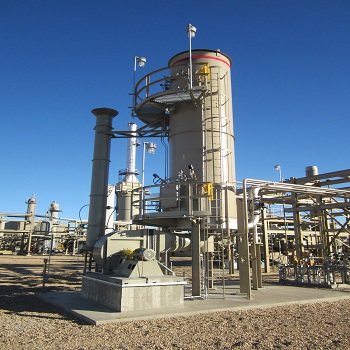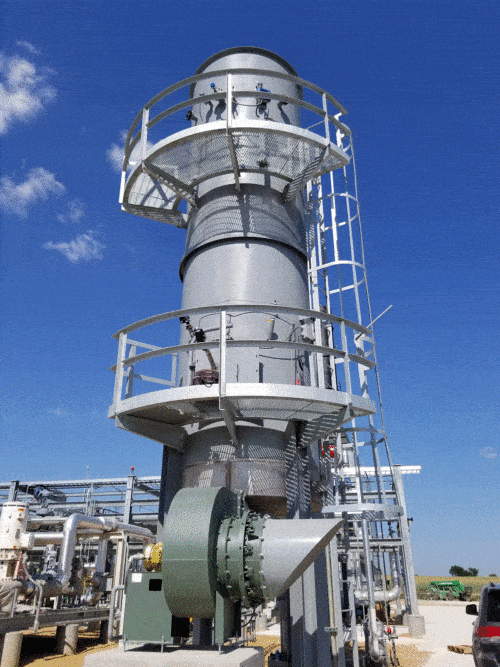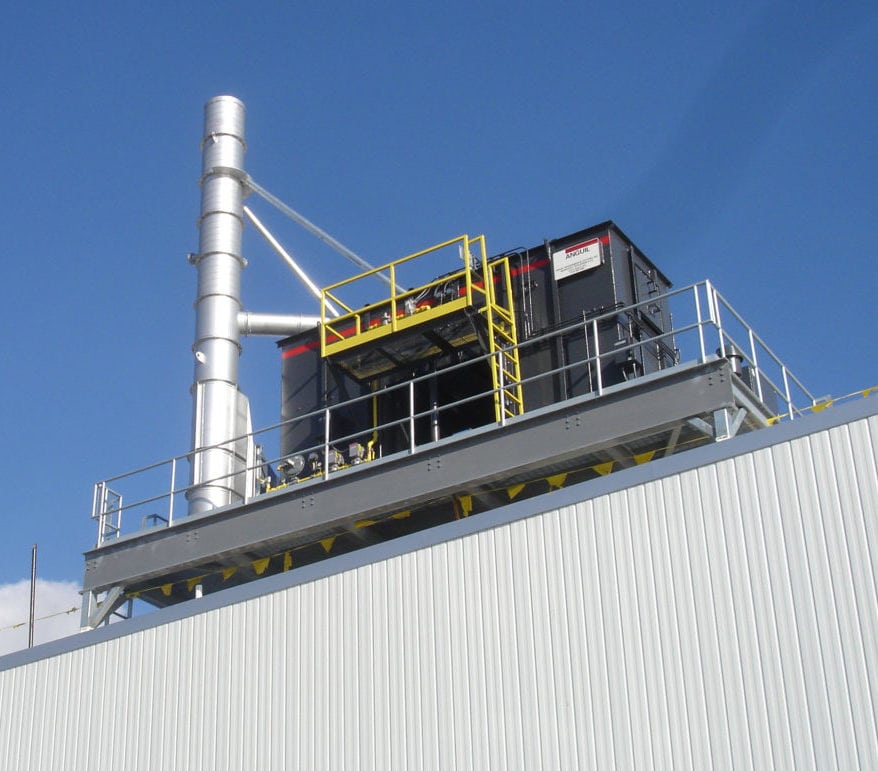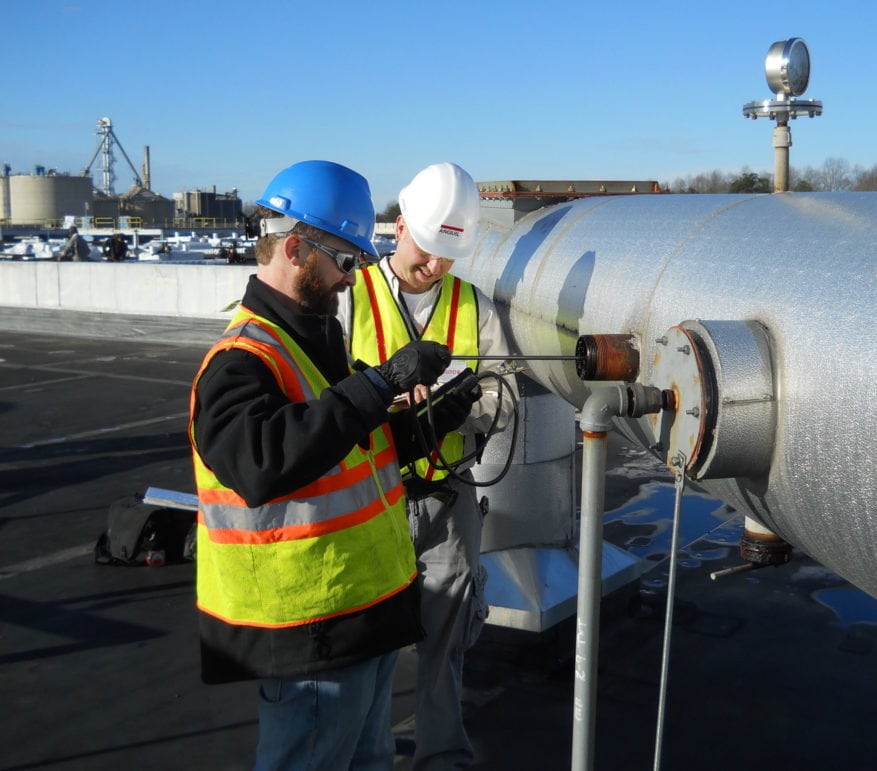This website uses cookies so that we can provide you with the best user experience possible. Cookie information is stored in your browser and performs functions such as recognising you when you return to our website and helping our team to understand which sections of the website you find most interesting and useful.
 Anguil’s Vapor Combustion Unit combines the simplicity of an enclosed flare with the destruction performance of a thermal oxidizer. Whether designed for intermittent use or installed on a continuous emission stream; the Anguil VCU technology has many advantages over other enclosed combustion systems. It is a robust device capable of handling varying emission flow rates and concentration changes.
Anguil’s Vapor Combustion Unit combines the simplicity of an enclosed flare with the destruction performance of a thermal oxidizer. Whether designed for intermittent use or installed on a continuous emission stream; the Anguil VCU technology has many advantages over other enclosed combustion systems. It is a robust device capable of handling varying emission flow rates and concentration changes.
Thermal flaring technologies used for the destruction of Hydrocarbons, Volatile Organic Compounds (VOCs) or Hazardous Air Pollutants (HAPs) are designed in two basic configurations; open and enclosed flame burners. Recent regulations on visible emissions, vapor radiation, Greenhouse Gases (GHGs) and noise pollution have driven industry away from open flaring and towards the enclosed vapor combustion system.
-
Product Overview
Benefits of Anguil’s VCUs
- Proprietary burner design eliminates visible emissions and the need for water or steam injection
- Air staging burner design further reduces Nitrogen Oxide (NOX) and Carbon Monoxide (CO) Output
- Skid mounted design simplifies installation and reduces costs
- Specialty burner design allowing multiple independent process streams to be injected separably and simultaneously.
99%+ Destruction Rate Efficiency (DRE), Regulatory Compliance Guaranteed
Optional Corrosion Resistant Coatings
Access Ladder & Platforms to Sample Ports & Combustion Chamber
Free Standing Construction
Forced Draft or Natural Draft Systems
Free Standing Fuel Train & Control Rack
Gas trains are designed to meet FM Global or any international certifications such as CSA, EN, TSSA or CGA.
Programmable Logic Controllers (PLCs): automate operation startup to shutdown, minimizing operator interface requirements. Remote telemetry capable with various enclosure options.
-
Air Flow Range & Efficiency
Air Flow Range
- Varying Flows & Concentrations
Turndown Capabilities
- 10:1 or greater
Destruction & Removal Efficiency
- Up to 99.9%
99%+ Destruction Rate Efficiency (DRE), Regulatory Compliance Guaranteed
Optional Corrosion Resistant Coatings
Access Ladder & Platforms to Sample Ports & Combustion Chamber
Free Standing Construction
Forced Draft or Natural Draft Systems
Free Standing Fuel Train & Control Rack
Gas trains are designed to meet FM Global or any international certifications such as CSA, EN, TSSA or CGA.
Programmable Logic Controllers (PLCs): automate operation startup to shutdown, minimizing operator interface requirements. Remote telemetry capable with various enclosure options.
-
Ideal Applications
Ideal Applications
- Varying process flow rates and vapor concentrations
- High emission destruction requirements
- Low maintenance demands
- Mixing operations, tank vents, loading stations and more
99%+ Destruction Rate Efficiency (DRE), Regulatory Compliance Guaranteed
Optional Corrosion Resistant Coatings
Access Ladder & Platforms to Sample Ports & Combustion Chamber
Free Standing Construction
Forced Draft or Natural Draft Systems
Free Standing Fuel Train & Control Rack
Gas trains are designed to meet FM Global or any international certifications such as CSA, EN, TSSA or CGA.
Programmable Logic Controllers (PLCs): automate operation startup to shutdown, minimizing operator interface requirements. Remote telemetry capable with various enclosure options.
FEATURES AND DESIGN OPTIONS
Features
- Process Gas Capacities Up to 100 MMBTU/H
- Destruction Rate Efficiencies Up to 99+%
- Multiple burner options for fuel input including natural gas, propane, and hydrogen as well as ultra-low NOx or electric heating elements
- High Turndown Capabilities / 10:1 or Greater
- Fully Integrated Burner Management System
- Stainless Steel Construction on Components Susceptible to Weather Damage
- Flame Arresting Burners for Flashback Mitigation and Safe Operation
- Reliable, Automatic Pilot Ignition Systems
- Sample Test & Sight Ports
- Gas trains are designed to meet FM Global or any international certifications such as CSA, EN, TSSA, CGA and ATEX.
- Robust Programmable Logic Controller (PLC) based controls with digital data recording, remote telemetry and various configuration options.
 Options
Options
- Knockout pots for upstream liquid separation
- Forced draft configuration
- Low, medium or high temperature designs
- Refractory lined with ceramic fiber insulation
- Heat transfer tubes for process heating needs
- Corrosion resistant metallurgies
- Detonation or deflagration flame arrestors
- Natural draft or forced draft combustion
- Various burner options including electric heating elements or multiple gas fuel inputs (natural gas, propane, hydrogen) and ultra-low NOx
Operating Cost Reduction Strategies
- Oxidizer Service and Preventive Maintenance Evaluations (PME)
- Secondary heat and energy recovery solutions for process heating needs
HOW DO VAPOR COMBUSTORS WORK?
Depending on the industry, the following terms may be used interchangeably to describe the vapor combustor technology: Low Emission Flare (LEF), Medium Temperature Flare (MTF), High Temperature Flare (HTF), Industrial Burners, Enclosed Flares, Biogas Flares, Gas Burners, Fired Heaters, Open Flame Flare, Candlestick Flare, Flare Stack, Thermal Combustors, Fire Box, Enclosed Burners, Vapor Combustor Units (VCUs).
Prior to the introduction of process gases, a purge sequence within the VCU is initiated to remove any existing combustibles from the device. The pilot ignites only after the system controls confirm a safe condition. The process gas is introduced to the system through an isolation valve or inlet duct. It is these process emissions which then begin fueling the combustion device.
Anguil’s vapor combustion unit can be designed in a natural draft configuration, negating the need for combustion air fans, or with a blower package under low process pressure conditions. In most cases, combustion air is drawn into the destruction chamber via one or more natural-draft air inlets. Modulating control dampers automatically provide the temperature control that ensures proper combustion temperatures for the oxidation of the various compounds.
For highly variable process conditions, both in terms of flow and hydrocarbon content, the emissions may be introduced to the combustion chamber through a number of different burner heads or stages. Staged introduction of process gases result in higher system turndown ratios and lower Greenhouse Gas (GHG) emissions like NOX and CO2. This stable, staged combustion burner also allows emission destruction to occur at low operating temperatures; typically between 1,500 and 1,800 °F (815 and 982 °C).
During operation, destruction of process gases in the combustion chamber is generally achieved through an exothermic reaction. When insufficient VOCs are present to maintain oxidation alone, supplemental fuel is required to reach destruction temperatures. The natural gas burner is only used for supplemental firing to maintain operating temperature and emission destruction during a low BTU content process gas condition. With the proper mix of time, temperature and turbulence, the VCU typically sees destruction efficiencies upwards of 99+%.







